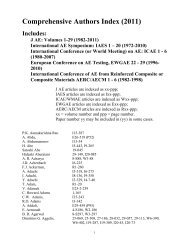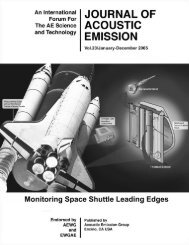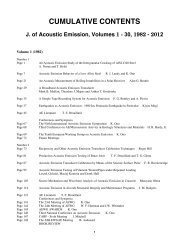- Page 3 and 4: JOURNAL OF ACOUSTIC EMISSION VOLUME
- Page 5 and 6: 25-194 ACOUSTIC EMISSION SOURCE LOC
- Page 7 and 8: Volume 25 (2007) AUTHORS INDEX DIMI
- Page 9 and 10: YUICHI TOMODA, 25-021 T. TOUTOUNTZA
- Page 11 and 12: Notes for Contributors 1. General T
- Page 13 and 14: In Memoriam H. Reginald Hardy, Jr.
- Page 15 and 16: STRUCTURAL INTEGRITY EVALUATION USI
- Page 17 and 18: The power-law AE behavior was recen
- Page 19 and 20: sorting out the original signals, e
- Page 21 and 22: Wood [36] in Australia has been usi
- Page 23 and 24: One needs to appreciate the difficu
- Page 25 and 26: In geotechnical applications, the p
- Page 27 and 28: methods include the use of combined
- Page 29 and 30: should take. Past attempts for stru
- Page 31 and 32: 11. Suzuki, T., Ohtsu, M., Aoki, M.
- Page 33 and 34: 40. http://en.wikipedia.org/wiki/Ma
- Page 35 and 36: Abstract ACOUSTIC EMISSION TECHNIQU
- Page 37 and 38: Fig. 1 Damage qualification by the
- Page 39: After adding the data of a tested s
- Page 43 and 44: (3) Corrosion Process of Reinforced
- Page 45 and 46: analysis. Corrosion cracking was si
- Page 47 and 48: ACOUSTIC EMISSION MONITORING OF REI
- Page 49 and 50: which - contrary to current beliefs
- Page 51 and 52: Fig. 4. Applied load (actuator 1) a
- Page 53 and 54: concrete and the jacket. Visual ins
- Page 55 and 56: Based on conventional analysis, AE
- Page 57 and 58: 2. Experimental The model pipe syst
- Page 59 and 60: pressure, respectively. This is ana
- Page 61 and 62: Fig. 6: Power spectra from fast Fou
- Page 63 and 64: small leaks (below 0.1 mm diameter)
- Page 65 and 66: ACOUSTIC EMISSION TECHNIQUE APPLIED
- Page 67 and 68: parameters in time domain and (c) m
- Page 69 and 70: above the threshold level of 40 dB
- Page 71 and 72: energy, i.e., high amplitude and lo
- Page 73 and 74: An optical microscopy observation o
- Page 75 and 76: Continuous WT (CWT) is defined as a
- Page 77 and 78: Fig. 8. Typical AE waveforms, their
- Page 79 and 80: followed by abrupt jumps in the det
- Page 81 and 82: E. Landis (1999), “Micro-macro fr
- Page 83 and 84: EVALUATION OF REPAIR EFFECT FOR DET
- Page 85 and 86: Fig. 2 Sensor array for tomography
- Page 87 and 88: 2 [ ] 2 k 3 9 2 2 1 f () 0 f ()
- Page 89 and 90: At these depths, a complicated and
- Page 91 and 92:
The number of AE hits after repair
- Page 93 and 94:
damage indices of Calm and Load rat
- Page 95 and 96:
PVDF is a semicrystalline polymer,
- Page 97 and 98:
After these preliminary tests, the
- Page 99 and 100:
of PVDF sensors does not seem to ha
- Page 101 and 102:
Fig. 10. Evolution of a typical PAD
- Page 103 and 104:
Fig. 17. Evolution of a typical dur
- Page 105 and 106:
I-G. Kim, H-Y. Lee and J-W. Kim (20
- Page 107 and 108:
Pencil-lead breaks are monopoles an
- Page 109 and 110:
Fig. 1 Displacement vs. time, sourc
- Page 111 and 112:
Fig. 5 Displacement vs. time, sourc
- Page 113 and 114:
Fig. 8 Displacement versus time for
- Page 115 and 116:
Fig. 10 Displacement vs. time. Sour
- Page 117 and 118:
Fig. 14 Signal amplitude versus tim
- Page 119 and 120:
To better relate these PLB and FEM
- Page 121 and 122:
HIGH-TEMPERATURE ACOUSTIC EMISSION
- Page 123 and 124:
thickness of 9 μm. The AlN element
- Page 125 and 126:
Fig. 5 Experimental setup for AE mo
- Page 127 and 128:
scales (and possibly salt cracks at
- Page 129 and 130:
DAMPING, NOISE, AND IN-PLANE RESPON
- Page 131 and 132:
The sharper resonance in Fig. 1c is
- Page 133 and 134:
i 2 RMS VDCC0 k BT = , g m 2 i
- Page 135 and 136:
ecause in-plane motion mostly produ
- Page 137 and 138:
4. B. Bahreyni, C. Shafai, Fabricat
- Page 139 and 140:
We first introduce our new quadridi
- Page 141 and 142:
Fig. 4 Amplitude profile as a funct
- Page 143 and 144:
Fig. 6 Change of room temperature (
- Page 145 and 146:
3) There are slight time lags in th
- Page 147 and 148:
Function Generator (FG) The functio
- Page 149 and 150:
Table 1 Results for continuous sens
- Page 151 and 152:
Fig. 7 pulse response XXX, filter :
- Page 153 and 154:
Fig. 11: Noise spectrum VS30-SIC-46
- Page 155 and 156:
waves propagate in a plate like str
- Page 157 and 158:
0.15 0 100kHz Driving pulse 10 100k
- Page 159 and 160:
0.45 0 100kHz Driving pulse 30 100k
- Page 161 and 162:
the sensor response to different fr
- Page 163 and 164:
CHARACTERISTICS OFACOUSTIC EMISSION
- Page 165 and 166:
Results and Discussion Shrinkage pr
- Page 167 and 168:
sapwood. Norway spruce wood consist
- Page 169 and 170:
most of the cells reached the fiber
- Page 171 and 172:
CHARACTERIZATION OF TITANIUM HYDRID
- Page 173 and 174:
Growth behavior of hydrides We stud
- Page 175 and 176:
were determined by the tensile test
- Page 177 and 178:
Figure 9 shows the Mode-I cracks in
- Page 179 and 180:
Results obtained are summarized as
- Page 181 and 182:
process of hydrogen destruction of
- Page 183 and 184:
Amplitude [dB] 60 55 50 45 40 35 30
- Page 185 and 186:
(Fig. 7) relative to the material a
- Page 187 and 188:
is shown in Table 1. Test specimens
- Page 189 and 190:
Fig. 4 Two types of AE signals dete
- Page 191 and 192:
the charging solution at 25 o C, by
- Page 193 and 194:
ANALYSIS OF ACOUSTIC EMISSION FROM
- Page 195 and 196:
nearly same waveforms for the first
- Page 197 and 198:
values). Most (11 of 14) of the rec
- Page 199 and 200:
Type-D (at 3.45 ms). In this sample
- Page 201 and 202:
NEURAL NETWORK BURST PRESSURE PREDI
- Page 203 and 204:
temperature, while the remaining se
- Page 205 and 206:
not properly set). This results in
- Page 207 and 208:
Conclusions Table 3 Summary of trai
- Page 209 and 210:
accurate source locations could be
- Page 211 and 212:
Fig. 1 Group velocities versus freq
- Page 213 and 214:
plane source orientation. But the l
- Page 215 and 216:
Fig. 9 Out-of-plane displacement vs
- Page 217 and 218:
Fig. 11 WTs of Fig. 8 with superimp
- Page 219 and 220:
Fig. 13 WTs of Fig. 10 with superim
- Page 221 and 222:
Table 3 At 102 kHz, WT peak arrival
- Page 223 and 224:
Fig. 17 Frequency of maximum WT int
- Page 225 and 226:
Fig. 18 Arrangement of sensors (#1,
- Page 227 and 228:
location calculation result that yi
- Page 229 and 230:
NOVEL ACOUSTIC EMISSION SOURCE LOCA
- Page 231 and 232:
tion resolution. It should be noted
- Page 233 and 234:
The specimen with numerous holes wa
- Page 235 and 236:
Fig. 5. Comparison of location meth
- Page 237 and 238:
Conclusions Delta-T source location
- Page 239 and 240:
Our approach This conceptual view c
- Page 241 and 242:
Voronoi Construction: Taking a case
- Page 243 and 244:
Fig. 6: Source location on a clamp
- Page 245 and 246:
PROBABILITY OF DETECTION FOR ACOUST
- Page 247 and 248:
POD is determined at the convergenc
- Page 249 and 250:
Fig. 2: Setup for illustrative runs
- Page 251 and 252:
Fig. 7: Probability of location (PO
- Page 253 and 254:
AE signals were filtered by high-pa
- Page 255 and 256:
Fig. 3 Accuracy and variations of a
- Page 257 and 258:
Fig. 7 Accuracy and variations of a
- Page 259 and 260:
eference data. The absolute values
- Page 261 and 262:
REAL-TIME DENOISING OF AE SIGNALS B
- Page 263 and 264:
600 500 400 300 200 kHz700 Frequenc
- Page 265 and 266:
the STFT result (Fig. 4(b)). Theref
- Page 267 and 268:
MONITORING THE EVOLUTION OF INDIVID
- Page 269 and 270:
the type of filtering, number of su
- Page 271 and 272:
was observed for either actuator. F
- Page 273 and 274:
Conclusions An experimental methodo
- Page 275 and 276:
the onset of pulses, consequently,
- Page 277 and 278:
zeros. The locations where a patter
- Page 279 and 280:
The reliability of the additional p
- Page 281 and 282:
AE MONITORING OF SOIL CORROSION OF
- Page 283 and 284:
Fig. 2 Cumulative AE counts with ap
- Page 285 and 286:
cumulative event counts and amplitu
- Page 287 and 288:
AE was monitored using three types
- Page 289 and 290:
Our conclusion from these tests is
- Page 291 and 292:
measurements with an Exxon Nuclear
- Page 293 and 294:
equipment manufacturer), CISE (AE t
- Page 295 and 296:
Automatic testing of receptacles du
- Page 297 and 298:
The finalized standards are: • EN
- Page 299 and 300:
14. Tscheliesnig P., Lackner G., He
- Page 301 and 302:
Fig. 1. Typical high-temperature cr
- Page 303 and 304:
• Emission rates are much higher
- Page 305 and 306:
Fig. 4. Results of AE monitoring of
- Page 307 and 308:
examination at 2000-5000X was able
- Page 309 and 310:
samples extracted from the beam aft
- Page 311 and 312:
The relative comparison of the size
- Page 313 and 314:
Fig. 3. Schema of VB Application fo
- Page 315 and 316:
Fig. 5. Microstructural observation
- Page 317 and 318:
Fig. 7 AE source locations for diff
- Page 319 and 320:
Fig. 9 CT images and corresponding
- Page 321 and 322:
A.M. Brandt, G. Prokopski, J. Mater
- Page 323 and 324:
conducted with AE technique. The AE
- Page 325 and 326:
After location of the events, inter
- Page 327 and 328:
The transit times of the individual
- Page 329 and 330:
6) B. Schechinger, T. Vogel, Acoust
- Page 331 and 332:
greater than the available anchorag
- Page 333 and 334:
location uncertainty and is the roo
- Page 335 and 336:
Figures 4 and 5 illustrate all loca
- Page 337 and 338:
ig cracks form, localization of AE
- Page 339 and 340:
ased on magnetic induction, while i
- Page 341 and 342:
Fig. 3. AE sensors positioning on b
- Page 343 and 344:
As a further evaluation of the degr
- Page 345 and 346:
EARLY FAULT DETECTION AT GEAR UNITS
- Page 347 and 348:
Acoustic Emission Analysis at Rotat
- Page 349 and 350:
The fixed bearing at the beginning
- Page 351 and 352:
The time-frequency components of a
- Page 353 and 354:
Additionally, the gear test bench h
- Page 355 and 356:
APPLICATION OF ACOUSTIC EMISSION IN
- Page 357 and 358:
Measurements of the acoustic backgr
- Page 359 and 360:
Fig. 6. RMS for different ranges of
- Page 361 and 362:
which indicate the transition from
- Page 363 and 364:
surface condition. It has already b
- Page 365 and 366:
( 2 1) 2) ! kx1 ! k c ! x + c ! k (
- Page 367 and 368:
Fig. 6: Signal above normal and def
- Page 369 and 370:
DAMAGE ASSESSMENT OF GEARBOX OPERAT
- Page 371 and 372:
The waveform streaming can be trigg
- Page 373 and 374:
Extracting features using different
- Page 375 and 376:
The classifier was used to identify
- Page 377 and 378:
ASL spectral energy is further calc
- Page 379 and 380:
2 #_ of _ Sensors 2 2 2 ( x ) (
- Page 381 and 382:
Simulated Failure Plane One hundred
- Page 383 and 384:
It has been documented that the ini
- Page 385 and 386:
(a) (b) (c) (d) 95% _ 98% 98% _ 100
- Page 387 and 388:
IMPACT IMAGING METHOD TO MAP DAMAGE
- Page 389 and 390:
e) Step d) was repeated until the a
- Page 391 and 392:
Panel A Panel B Panel C Panel D Fig








